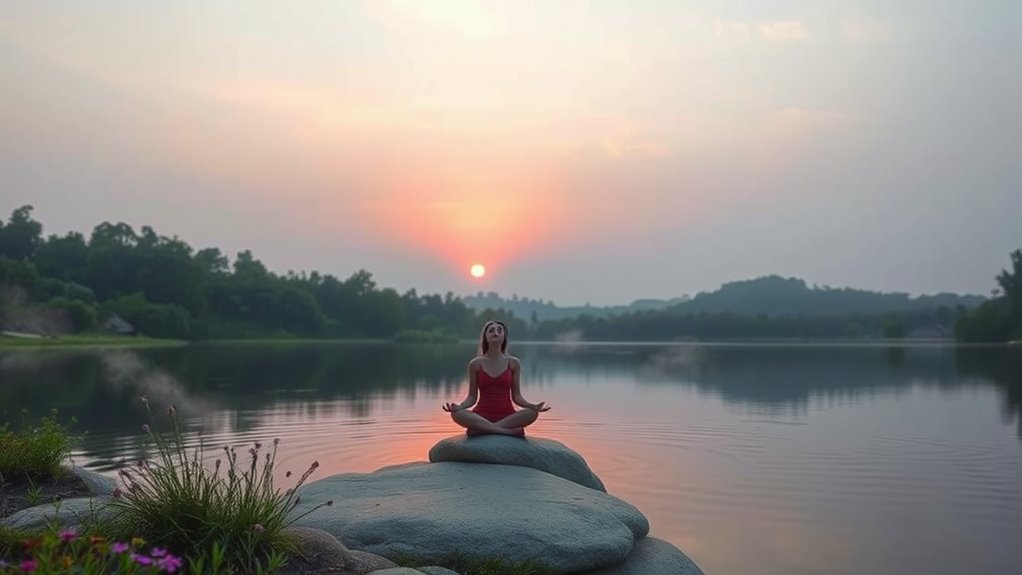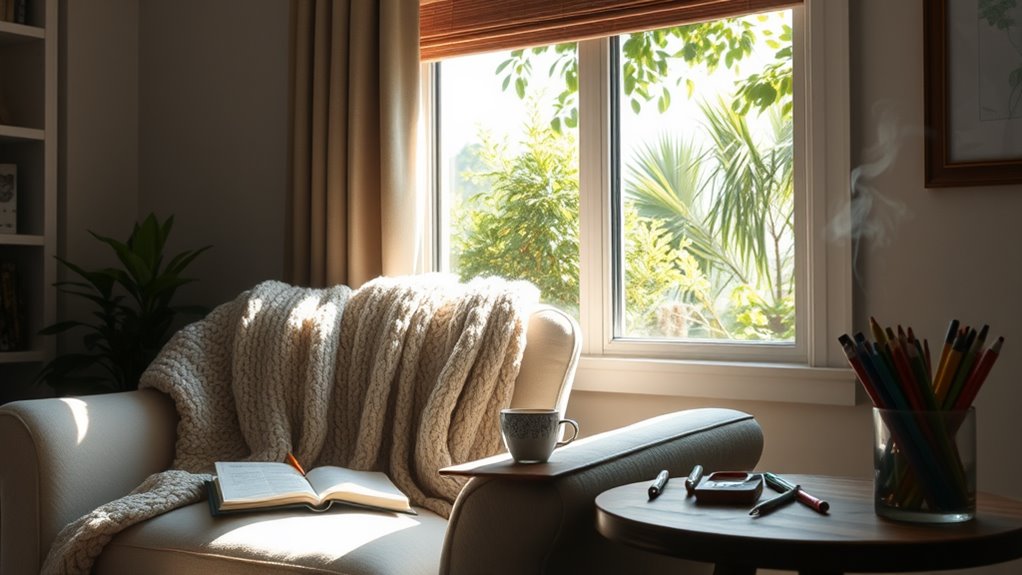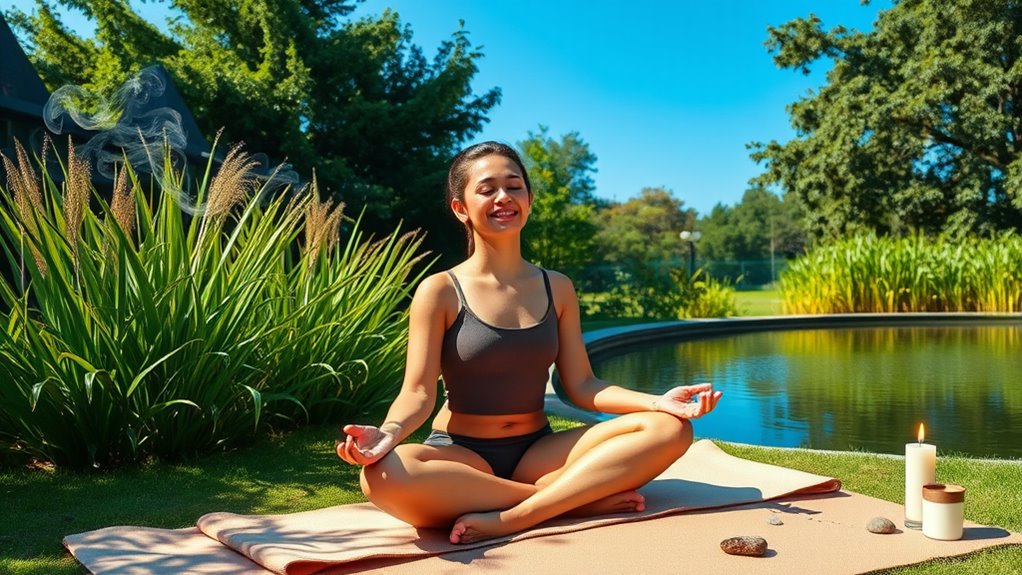Relaxation Techniques You Can Do Anywhere (Even Work)
You can easily incorporate relaxation techniques into your day, even during a busy work shift. Start with deep breathing exercises: inhale deeply through your nose and exhale slowly to release tension. Try mindful visualization by picturing a peaceful scene that engages your senses. Progressive muscle relaxation helps, too—tense and then relax each muscle group. Don’t forget quick stretching techniques to boost energy and flexibility. Finally, keep essential oils handy for an instant mood boost. With these tips in your toolkit, you’ll find stress relief is just a moment away, and there’s even more to explore.
Key Takeaways
- Practice deep breathing exercises by inhaling deeply, holding briefly, and exhaling slowly to activate relaxation anywhere, even at your desk.
- Engage in mindful visualization by imagining serene landscapes, using all your senses to break away from stress and re-center your thoughts.
- Use progressive muscle relaxation by tensing and relaxing muscle groups from feet to face to enhance your sense of calm throughout the day.
- Incorporate quick stretching techniques like neck stretches, side stretches, and leg stretches to boost energy and flexibility in just a few minutes.
- Utilize aromatherapy on the go with essential oils or personal diffusers to provide instant mood boosts and enhance your workspace environment.
Deep Breathing Exercises
Deep breathing exercises are a powerful tool for relaxation and stress relief. When you take a moment to focus on your breath, you activate your body’s natural relaxation response.
Start by sitting comfortably, inhaling deeply through your nose, and filling your lungs. Hold that breath for a few seconds, then exhale slowly through your mouth. You’ll feel tension release with each breath out.
Try to repeat this process several times, letting your mind clear with every exhale. You can practice this technique anywhere, whether you’re at your desk or in a quiet corner.
Mindful Visualization
As you close your eyes and picture a serene landscape, mindful visualization can transport you to a place of tranquility.
Imagine a beach with soft waves lapping at the shore or a quiet forest filled with the scent of pine. Engage all your senses; feel the warmth of the sun on your skin, hear the rustling leaves, and breathe in the fresh air.
This technique helps you break away from stress and re-center your thoughts. Spend just a few minutes exploring this mental space, letting go of any tension.
When you’re ready, open your eyes and carry that sense of calm back into your day. Practicing mindful visualization regularly can enhance your overall well-being and resilience in challenging situations.
Progressive Muscle Relaxation
Mindful visualization creates a peaceful mental space, but to further enhance your relaxation, try progressive muscle relaxation.
This technique involves tensing and then relaxing different muscle groups in your body, helping you release built-up tension. Start by finding a comfortable position, either sitting or lying down.
Focus on your feet; tense the muscles for five seconds, then let go. Move to your calves, thighs, and work your way up to your neck and face.
As you release each muscle group, pay attention to the sensations of relaxation spreading through your body. This practice can be done anywhere, even at your desk.
It’s a simple yet effective way to improve your overall sense of calm and well-being throughout the day.
Quick Stretching Techniques
In just a few minutes, quick stretching techniques can greatly boost your energy and flexibility.
Try these simple stretches at your desk or during breaks. Start with a neck stretch: tilt your head to one side and hold for 15 seconds, then switch sides.
Next, extend your arms overhead and gently lean to each side to stretch your sides. For your back, sit tall, twist your torso to one side while keeping your hips facing forward; hold, then switch.
Don’t forget your legs! Stand up, grab one ankle behind you, and hold for 15 seconds to stretch your quads.
Incorporating these quick stretches throughout your day can help you feel more relaxed and focused, making work feel less stressful.
Aromatherapy on the Go
Whether you’re commuting, traveling, or simply moving between tasks, aromatherapy on the go can provide an instant mood boost and relaxation.
Essential oils are easy to carry and can transform your environment in seconds. You might consider using a rollerball applicator filled with calming lavender or invigorating peppermint. Just a quick swipe on your wrists or temples can help clear your mind or lift your spirits.
If you prefer a more subtle approach, try an aromatherapy inhaler. Inhale deeply whenever you need a break.
Many people find that diffusing oils through a personal diffuser necklace or bracelet also works wonders. No matter where you are, a little aromatherapy can make a big difference in how you feel throughout your day.
Guided Meditation Apps
Carrying a calming scent with you can set the stage for relaxation, but sometimes you need a more structured approach to unwind.
Guided meditation apps offer a perfect solution. With just a few taps on your phone, you can access a variety of meditations tailored to your needs. Whether you’re dealing with stress, anxiety, or simply need a mental break, these apps guide you through the process, making it easy to focus and relax.
Many apps provide short sessions designed for busy schedules, so you can practice during a break at work.
Features like soothing sounds and expert guidance enhance your experience, helping you cultivate mindfulness and inner peace wherever you are.
Give one a try, and find your calm today!
Simple Desk Yoga
While you may feel stuck at your desk, incorporating simple desk yoga can refresh your mind and body.
Start with seated twists: sit up straight, place your right hand on the back of your chair, and gently twist to the right, then switch sides.
Next, try neck stretches; tilt your head to one side and hold for a few breaths before switching.
You can also do wrist stretches by extending one arm in front and gently pulling back on your fingers with the opposite hand.
Finally, take a few deep breaths, inhaling through your nose and exhaling through your mouth.
These quick moves can relieve tension and boost your focus, helping you feel more energized and productive throughout the day.
Frequently Asked Questions
Can Relaxation Techniques Improve My Productivity at Work?
Yes, relaxation techniques can boost your productivity at work. By reducing stress and enhancing focus, you’ll find it easier to tackle tasks efficiently. Just a few minutes of practice can greatly improve your overall performance.
How Long Should I Practice These Techniques Daily?
You should practice these techniques for at least 10 to 15 minutes daily. Consistency is key, so try incorporating short sessions throughout your day to help maintain focus and reduce stress effectively.
Are There Any Side Effects of These Relaxation Methods?
While most relaxation methods are safe, you might experience mild side effects like drowsiness or temporary discomfort. It’s important to listen to your body and adjust your practice if you notice any negative reactions.
Can I Use These Techniques During Stressful Meetings?
Absolutely, you can use these techniques during stressful meetings. Just take a deep breath, focus on your body, and practice mindfulness. It’ll help you stay calm, centered, and engaged without drawing attention to yourself.
What if I Feel Uncomfortable Practicing These Techniques in Public?
It’s understandable to feel uncomfortable practicing techniques in public. Start small by incorporating subtle movements or deep breathing. Gradually, you’ll gain confidence, making it easier to use these methods wherever you are, even in public.





